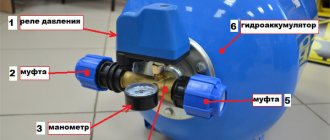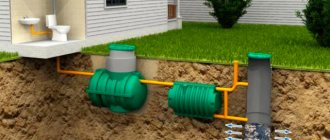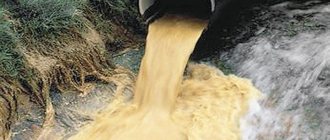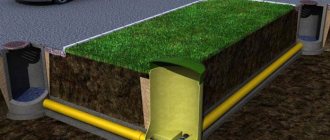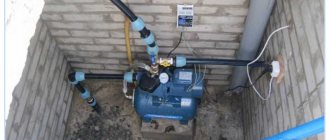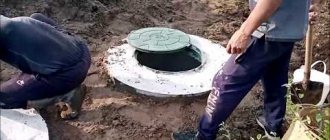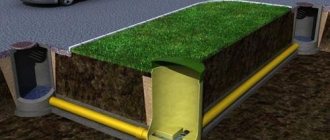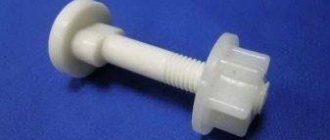Most owners of sites both within the city and outside it are faced with the issue of wastewater disposal during construction. A less labor-intensive and more effective solution is the use of local wastewater treatment plants (WTP). The distance from the septic tank to the well is an important aspect of the installation and the SNiP and SanPiN standard, on which the safety of residents depends. A septic tank, being an analogue of a cesspool, with significant savings allows you to maintain the environmental background at the required level under a number of conditions.
Near the well
What do you need to start from?
The exact distance from the septic tank is regulated by the Federal Service for Surveillance on Consumer Rights Protection and Human Welfare (Rospotrebnadzor). Refers to the federal executive authorities, specializing in control and supervision of the sphere of ensuring sanitary and epidemiological safety of the population of the Russian Federation.
At the stage of designing the location of the septic tank, it is necessary to adhere to a number of sanitary and epidemiological rules and regulations (SanPiN), as well as building codes and regulations (SNiP):
- SNiP 2.04.03-85 “Sewerage. External networks and structures" is the main document containing the essence of the topic raised.
- SNiP 2.04.01-85 “Internal water supply and sewerage of buildings” is a standard that includes standards for the distance of settling tanks from drinking water.
- SanPiN No. 2.1.5.980-00 “Hygienic requirements for the protection of surface waters” - a list of rules characterizing the boundary of the protection zone relative to the surface of reservoirs.
- SanPiN 2.2.1/2.1.1.1200-03 “Sanitary protection zones and sanitary classification of enterprises, structures, and other objects” - a document regulating the passage of sanitary zones around objects that pose a potential danger (which include septic tanks)
- SanPiN 42-128-4690-8 “Sanitary rules for the maintenance of territories of populated areas”, regulating the rules for arranging a septic tank.
These regulations list all current distances to objects located on the land plot and beyond. The conditions for their installation, operation and maintenance are described in detail.
Features of installation of sewer and water supply communications
Water supply and sewerage are mandatory attributes of a modern private home. If the first system helps in the delivery of water, then the second in its removal. In the case where the central water supply network is not connected to the site, the source is a well or a well. It is important to place clean water pipes so that they are at a sufficient distance from the sewer pipes.
The distance between incoming and outgoing pipes is regulated in accordance with SNiP 2.07.01-89 and must be at least 40 cm when arranged in parallel. Intersection is allowed only at an angle of 90 degrees, and the water pipe must be 40 cm higher than the sewer pipe. At the entrance to the house, the distance should be at least one and a half meters.
When using polymer pipes, additional protection must be provided at intersections. 5-10 cm casings are used.
In different regions of the country, depending on climatic conditions, these distances may be subject to change.
IMPORTANT! Failure to maintain the required distance between water supply and sewerage pipes can lead to poisoning of drinking water and health problems for residents of the house.
Minimum padding
Existing regulations require strict compliance with the following territorial location rules:
- Distance from the source of drinking water – 20-50 m.
- The distance from the border with the neighboring property is 3 m.
- Location relative to a pond, lake, other body of water with stagnant water - 30 m. To the river - 10 m.
- Location near the house - at least 4 m.
- Distance from the road (regardless of the type of surface: asphalt, soil, concrete) – 5 m.
Distance of the septic tank from objects of various purposes Source aquasistem.ru
Obviously, the above standards regulate not only the location of the septic tank relative to the source of drinking water, but also the remoteness of other nearby objects: houses, roads, reservoirs, boundaries of the land plot.
Requirements for a septic tank
As mentioned earlier, the list of conditions that a cesspool must meet is listed in SanPiN 42-128-4690-8 and the previously unnamed SNiP 30-02-97. The contents of the documents provide for a number of requirements for the location and design of the septic tank. We will not study these regulations in full; we will only reveal their main essence:
- The settling tank must be located on an area that is entirely the property of the land user.
- The distance from it to the main water supply should not be less than 10 m. For lower values, you will receive SES approval.
- The depth of the cesspool should not exceed 3 m. However, here one more mandatory condition must be taken into account. It lies in the distance from the bottom of the septic tank to the top point of groundwater. Its minimum value is 1 m.
- A hermetically sealed window, door, and hatch are installed in the ground part of the drainage pit.
- Filling the sump higher than 35 cm from the top edge is not allowed.
- Pumping is carried out as it is filled, but not less than once every 6 months.
- When pumping out, disinfection must be carried out.
What should a cesspool be like? Source stroiteli124.ru
conclusions
With the development and advent of septic tanks made of plastic, there was no longer a need for difficult construction procedures, such as installing and concreting the rings of the structure. At the same time, it was possible to avoid problems associated with metal corrosion, which was the most common reason for the depressurization of structures for cleaning. Now, if there is limestone under the soil layer, there is no need to drill it; you can simply dig a hole of the required depth. However, in any case, it is worth remembering in what interval drilling of a well is allowed.
When owners turn to professionals during installation work, in such cases it becomes possible to reduce the distances approved by the standards. In addition, the provisions themselves contain some exceptions that can be taken into account. For example, the distance from the water supply to communications can be reduced if cast iron water pipes were used for construction.
Penalties
The contents of a septic tank pose a threat to human health and the environment. Unauthorized installation is prohibited by law and must be eliminated. To obtain permission, you will need to apply with a pre-approved project to the SES or Rospotrebnadzor.
You can get a positive answer only when the project is developed in such a way that it does not contradict existing regulations and a number of rules. After receiving permission to carry out the work, the owner of the site can begin installing a septic tank. It is not recommended to cheat and deviate from the contents of the developed scheme, since as a result of detection this will be reflected in a number of penalties.
In addition, it must be taken into account that an inspection commission may arrive at the site at any time. The purpose of her visit is to verify the actual and documentary distances of the septic tank. Based on the results of the activities carried out, a compliance report is drawn up, which will indicate the detected deviations (if any).
Any violation of the installation or operation of a septic tank may result in sanctions in the form of a fine or a ban on further use with forced dismantling of the structure. The penalty is determined based on the seriousness of the current situation and previously recorded cases of ignoring legal requirements.
Healthy! Violation of the above standards implies administrative liability in the amount: for legal entities - from 20,000 to 250,000 rubles, for individuals - from 1,500 to 20,000 rubles. In case of repeated violations or large-scale damage to the environment, criminal liability is permitted.
Drawing up an inspection report Source sovet-ingenera.com
The following situation can be cited as an example. The owner of a country house built a regular septic tank with a filter bottom. However, he did not take into account that such a design can be used if the volume of drained waste per day does not exceed one cubic meter. In his situation, the release is much greater, which is documented. Let's say this is done taking into account the readings of the cold/hot water meter.
In this situation, the owner of the house faces a fine, the amount of which is determined by the magistrate and will depend on the degree of violation of environmental standards.
Disagreements over the location of the septic tank Source www.ogorod.ru
If, as a result of a complaint received from neighbors, a one-time violation of the rules for using a septic tank is revealed, the violator will receive a warning in which it will be strongly recommended to eliminate the problem and resolve the issue peacefully.
Depth of location of the well and treatment tank
When designing the location of treatment facilities, one should take into account not only the distance at which to drill a well from the septic tank, but also such a parameter as the depth of the sewer tank, which is primarily determined by its type and design. The most acceptable treatment facility is one consisting of three tanks, the third of which is the deepest.
When the first two tanks, smaller in size, are sealed, then from the third the water goes into the ground through a crushed stone drainage layer equipped at the bottom. It is also allowed to pump out liquid using drainage pumps, using it, in particular, for watering plantings. In this regard, there is no need to clean the container.
Considering the source of water on the site itself, it is worth noting some features of its creation in relation to the standards applied to septic tanks. The quality of drinking water is determined by the depth of water intake: the deeper, the purer. The best option, which can be compared with the extraction of artesian water, is a well “for limestone” (from 70 to 300 m).
Webinar “How to choose a septic tank for a country house” from the Novoe Mesto company
A deeper well eliminates the risk of contamination by wastewater, since when penetrating to a depth of 60 m or more, natural wastewater treatment occurs due to the layers of soil through which it passes. The danger comes from water layers, which, when mixed with contaminated water, can get into the drinking layer if the casing is poorly made.
The tightness of the casing of the pipe is ensured by a metal pipe running along the first 25 m of the well, with plastic pipes installed inside it and a hose to a specially selected pump that pumps water into the accumulator. From the hydraulic accumulator, water is distributed through the water supply system to water collection points on the site and in buildings.
What else to pay attention to
When designing the location and design of a septic tank, it is necessary to pay attention to a number of conditions that will further facilitate its installation and simplify subsequent operation. The most significant are:
- If possible, based on the characteristics of the land, select a location for the septic tank where, even if it depressurizes, dirty water will not get into clean water (surface, groundwater).
- Acceptable values are determined individually and calculated depending on the type of soil. In this situation, the filtering properties of the latter play the main role. For example, wastewater that passes through clay is purified better than wastewater that percolates through sandy soils.
- The optimal choice would be to locate the septic tank below the level of the water intake structures, although this condition does not apply to all areas. At the same time, it is not recommended to equip it in a lowland due to the high probability of filling with melt and rainwater.
- We should not forget about the level of soil freezing and try to arrange a sump below this level. Although, with almost 1.5 m, corresponding to the Moscow region, this most likely will not be possible. To avoid a possible problem with sewer freezing, try to insulate the pipeline or extend the heating cable.
Schematic location of the septic tank on the site Source kanalizaciya1.ru
Healthy! If, as a result of repeated attempts, you have not been able to find the best place for the sump, contact a specialist.
General recommendations
The stated rules and recommendations of specialists allow us to conclude that during the installation of wastewater treatment lines it is not enough to be guided by building codes and sanitary and epidemiological standards. In this matter, to ensure the best comfort, it is best to use the services of specialists.
Professionals will take on not only the responsibilities for developing design documentation and placing equipment according to all rules, but will also share responsibility in the event of unforeseen breakdowns.
Structures made of concrete rings
During installation of equipment, it is also important to ensure compliance with the following rules:
- The sump must be located below the soil freezing level (compliance with this requirement will allow you to use this equipment throughout the year. If it is impossible to comply with this standard, it is recommended that the communication pipes be securely wrapped in thermal insulation material.
- In the case of digging a pit in clayey or loamy soils, before installing the septic tank, it is more advisable to mount an additional concrete substrate at the bottom of the recess (a sump tank must subsequently be placed on the prepared site. Otherwise, the risk of equipment being pushed out during seasonal changes in the soil or the sealing of auxiliary communications is damaged increases).
- It would also be useful to equip a filtration field or well. The key factor in this situation is the depth of groundwater - if this value is high, it is advisable to install an inspection well through which to monitor the level of liquid in it. As a rule, it is made and installed using concrete rings.
Where to place a septic tank on 6 acres
The requirements specified in regulations are not always applicable in real life situations. For example, with the size of the minimum plot allowed to fall into the category of individual housing construction, 20 by 30 m, it is not possible to make such indentations. There are several ways to solve this problem:
- Pre-develop a building plan. In most cases, lack of distance occurs due to untimely planning. If at this stage you think through all the possible nuances and move the source of drinking water and the sump in different directions, you will be able to solve the problem.
- Increase the waterproofing properties of the soil. The easiest way is to add clay, which acts as an excellent natural filter. This can also be done in other available ways.
- Change the performance of the cesspool. In this situation, it is necessary to understand that if the volume of wastewater contained in the settling tank decreases, the requirements for compliance with sanitary and epidemiological standards are reduced.
- Integrate a biofilter into the sewage system. The device acts as an independent septic tank with an increased degree of purification. With it, the requirements for maintaining the distance from the septic tank to the source will be less. In addition, water can be discharged into a regular pit.
Depth of the septic tank Source pro100septik.ru
In fact, the construction of wells for the extraction of artesian water involves drilling a hole up to 50 m deep (it can also be deeper). In a high-quality design, water pumped from the bowels of the earth will never mix with what will be in the septic tank. Even if there is no more than 10 m between them.
However, artesian wells require maximum concentration of professionalism of the performers and regular preventive maintenance of the condition of the casing pipes. These conditions are not always met; as a result, there is a risk of food poisoning from products that get into drinking water from the upper layers (sewage, rain, contents of the sump).
The difference between an artesian well and a well Source septik-i.ru
Healthy! The difference between a well and a well is that the first supplies water from deep (50 or more meters) layers, the second - from the upper (no more than 25 m).
Current standards
Often supervisory authorities can present owners of small plots with tasks that are impossible to complete. In this regard, it is advisable when planning the development of a site to provide for all current sanitary standards and rules. Well in the area adjacent to a private building:
In other words, the layout of the site should be drawn up based on the order of location of the septic tank and artesian well, as well as the interval between them.
The distance between these two structures is determined together with practical experience and scientific work, which is combined into a single standard. In addition, fire safety criteria are provided for buildings with an increased risk of fire.
After the law on dacha plots comes into force, providing for their transfer to SNT, as well as the possibility of registration or construction on the area of individual housing construction.
In this regard, some details should be taken into account:
- To register a constructed building as an individual housing construction, as well as to transfer it from non-residential to residential, strict compliance with SanPiN standards is necessary, that is, you need to have an equipped well and septic tank. Typically, such areas are minimally equipped exclusively for seasonal living. Then it is necessary to make a cesspool for waste, which should then be destroyed. This is permissible if the structure is built in accordance with the standards for the use of a certain number of people. In this case, the well is the main source of water.
- If the dacha building was completed in violation of any standards, then when registering it, you need to keep in mind other requirements. For example, distances for an artesian well and a septic tank. And when a new SNT does not have a central sewerage system or a functioning water supply, then there is a need to make changes to the structure, which is not suitable for permanent residence. That is, drilling a well and placing a septic tank.
Submarine diagram:
In practice, a pit intended for storing and destroying waste is an extremely unreliable structure, since it is accompanied by the spread of unpleasant odors and insects. These consequences often cause conflicts with neighbors. Such a pit is not comparable to the use of modern septic tanks. In addition, a large family uses a lot of water, then the septic tank needs to be installed with the optimal volume.
